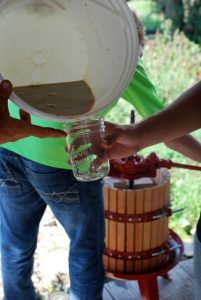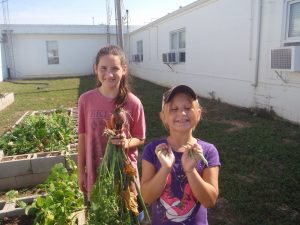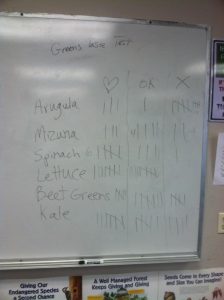Final Report for YENC15-088
Project Information
-
- Ozark County Times Article
 Students pressed and sampled cider from local apples on the tour of Stella Luna Farm
Students pressed and sampled cider from local apples on the tour of Stella Luna Farm
- Elementary students show off their harvest from the Lutie School garden
 The results of our "Greens Taste Test" at Lutie School
The results of our "Greens Taste Test" at Lutie School
Project Duration: August 2015- June 2016 (11 months)
Date of Report: February 15, 2017
PROJECT DESCRIPTION AND RESULTS
BACKGROUND
During college in Kirksville, Missouri I volunteered at Ray Miller Elementary School’s garden and also prepared and taught students a hands-on lesson about composting for a class assignment. I later worked with the 4-H program in Howell County, Missouri. I hosted a series of garden workdays for middle school age 4-Hers as well as members of the local Boys and Girls Club at the West Plains Community Garden. Later, while serving as an Americorps VISTA for the non-profit One Garden Inc. I worked with middle and high school students at two schools to start and transplant heirloom tomato seedlings that were distributed to the local community. I became acquainted with the staff and students at Lutie School during that project and eventually applied for this grant in order to work with them again.
GOALS
Generally speaking, the goal of this project was to get youth excited about eating fresh vegetables and encourage them to take an active role in growing food. I also hoped this project would raise general public awareness of sustainable agriculture techniques, and increase access to fresh healthy foods by sending produce home with students.
The specific goals were for the high school and middle school Agriculture students to:
Learn how to grow vegetables and share their knowledge with family and neighbors
Gain job skills related to sustainable agriculture
Learn the three pillars of sustainable agriculture and why they are important
Understand the benefits of local food production
Learn the nutritional benefits of eating fresh vegetables
Gain an understanding of food insecurity and health issues in their community
Learn about specific farming practices including: cover cropping, water conservation, season extension, and rotational grazing.
Goals for the elementary school students were to:
Learn basic sustainable gardening practices
Learn the nutritional benefits of eating fresh vegetables
PROCESS
The focus of this project was hands-on work and observation, but I used a variety of approaches in order to engage each student according to their needs and interests.
The project consisted of two parts: the field trip to Stella Luna Farm and hands-on lessons at Lutie School. We did the field trip first, which I think worked well because it got the students interested and inspired, and also served as a bit of an icebreaker. The intention was to have the students apply what they saw and learned at the farm to their school garden. I think starting with the tour also provided a reference point for those who had no previous gardening experience. It would have been fun to do a follow-up visit to Stella Luna Farm to give the students a chance to show what they had learned by helping with a project.
After the field trip I visited the school several times during the fall 2015 and spring 2016 semesters and worked in the garden and greenhouse with them. We started seeds, planted, weeded, harvested, and of course sampled the produce. The older students took on leadership roles when we worked with the elementary school students in their class garden beds.
I also spent a couple of rainy days doing classroom lessons with them. I wanted to emphasize books as a resource for gardening questions, so we did an activity where each student researched a different garden crop and created a reference page about it. We also spent a day talking about the more abstract concepts including “the 3 pillars”, and conventional vs. sustainable agriculture. I showed videos from the “Feeding 9 Billion” series by Dr. Evan Fraser and PBS Food’s “Lexicon of Sustainability” and led a group discussion. April Wilson with the NRCS led a great discussion about the importance of agriculture in everyday life. We did a mapping activity to demonstrate the huge number of people who are involved in agriculture, from truckers, to processing plant workers, to equipment manufacturers, and non-profit groups. She explained some of the trends in agricultural policy, and how non-profit and government programs are increasing support for non-traditional farmers and sustainable practices. We also discussed the aging farmer population and consolidation of farms, and how important it is for young people to take an interest in farming. Hopefully we encouraged them to consider an agriculture related job.
I think the combination of the farm visit, hands-on activities, discussion, research, videos, and presentations helped cover a wide variety of learning styles and interests. Many of the students who seemed problematic in a classroom setting really stepped up when we were working in the garden, and others who were less excited about pulling weeds did great work on their crop reference pages. I think the sessions where we got to harvest and eat produce were the most successful. I did a “greens taste test” with arugula, mizuna, spinach, kale, beet greens and lettuce from my home garden and let everyone vote for the best and worst. They also really enjoyed daring each other to try jalapenos. Even though it’s very simple, I think having fun trying new things and eating things they helped grow will stick with them the longest.
PEOPLE
Derek Cornett is the Agriculture Teacher and FFA Advisor at Lutie School. Derek helped me conduct lessons and keep students on track throughout the project. He also directed students in the greenhouse and gardens.
School superintendent Scot Young rounded up plants and supplies and helped coordinate the project. Several other teachers worked in the school garden beds with their classes.
Rachel and Jeff Barry operate Stella Luna Farm. Rachel is also a licensed dietitian. Jeff and Rachel hosted the farm visit and helped plan and conduct the tour and activities. They also organized the meal, which utilized ingredients from their farm as well as other local producers.
April Wilson, Resource Conservationist with the Natural Resources Conservation Service (NRCS) gave a great presentation to the freshman class about careers in agriculture and the changing demographics of today’s farms.
Daniel Roth and Vinnie McKinney, Executive Director and President of non-profit One Garden Inc. helped with project planning, and provided support to me throughout the project.
RESULTS
My primary audience was middle and high school students, who live in a very rural and poor area. The local food trend is just starting to reach our part of the country, and there aren’t many commercial farms producing fruits or vegetables for local sale. However, several students had home gardens or remembered their grandparent’s gardens. The youth I worked with were enrolled in various agricultural classes, but had not studied much about vegetable production or specific techniques in sustainable agriculture. I also reached elementary school students, teachers, and other school staff from the same demographic.
It’s likely that not every student could list the three pillars of sustainable agriculture several months after the project ended, but I do think they came away from the project knowing that it’s important to know where food comes from, that agriculture should be profitable, but also good for people and the environment, and that we can each be involved in agriculture whether it’s by putting out a garden or shopping at a local farmers market. Students also observed and learned about specific sustainable agriculture practices such as composting, cover cropping, rotational grazing, no-till, etc. as well as broader concepts like water conservation and biodiversity.
Another important part of the project was presenting the students with positive role models (including myself, the Barrys, and April Wilson) who are involved in sustainable agriculture in the Ozarks. I think having the opportunity to interact with adults outside of their teachers and families was very beneficial to the youth, and also made them more willing to engage.
I used worksheets to track their comprehension of sustainable agriculture concepts and practices, as well as student’s observations on the farm tour. I also held group discussions to help students further understand the ideas and prompt critical thinking. The mini research project on garden crop requirements gave the students a chance to find information and compile it in a useful way. In a show of hands post-project survey, 10 out of 10 students answered “yes” to the following questions: I learned about growing vegetables, I would like to start a garden at home, I have talked with my family, friends or neighbors about gardening or farming, I am interested in a job related to agriculture, I learned that sustainable agriculture is good for people, the economy, and the environment, I learned that eating fresh vegetables is good for my health.
DISCUSSION
I went into the project thinking that I would be more focused on challenging their existing knowledge by teaching them about alternative methods to pesticides, synthetic fertilizers, rototilling and the like. In reality, these students didn’t know much of anything about how food is actually grown (or didn’t think they did), but at the same time, many of them had a vague perception that we need to use less chemicals, conserve natural resources, treat animals more humanely, and buy local. I also learned that the same goes for many adults, and I think even the teachers learned a lot and got more interested in gardening.
If doing this project again I would shorten the timeline and focus on additional field trips. The students really seemed to enjoy working in their school garden, but in the future I think the teachers will be able to take that part on.
OUTREACH
Our field trip and project were reported on by the Ozark County Times in the article “Lutie school promotes learning through school garden and sustainable farm tour” October 14, 2015.
Teachers have taken photos of the garden on a regular basis and shared them on the Lutie School Facebook page, which currently reaches 529 followers.(https://www.facebook.com/Lutie-R-VI-School-District)
On October 27, 2015 I gave a presentation and slideshow to the Ozarks Heritage Garden Club, based in Theodosia, Missouri. Approximately 20 members attended the presentation, and the group expressed interest in engaging with the school garden.
On April 2, 2016 I presented on the project to a crowd of around 50 people at the third annual “Community Congress on Prosperity Through Local Food and Energy Independence” hosted by community organization Ozarks Neighborly Exchange.
PROGRAM EVALUATION
I really appreciate that the SARE Youth Educator Grant application is accessible and fairly straightforward. One suggestion would be to change the timeline to line up better with the school year and growing season. For example, it would be good to get funding announcements earlier in the Winter so that garden related projects could start early in the Spring semester. On a minor note, the formatting for submitting reports is a little frustrating. I think the report would look much neater if each report section were separated out, rather than having us paste the whole report onto a blank page.